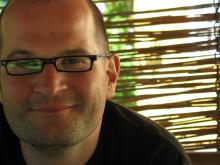By Katherine Duke '05
Throughout her college years, Deidra Montgomery ’10 has been meeting up with other enthusiasts to raise her voice in a singing tradition called Sacred Harp. Now she’s conducting a formal study of her fellow singers. “I’m looking at who the Western Mass [Sacred Harp] community is, who makes it up and what a regular singing is like,” she says. Phil DuPont ’12 has been attending three Catholic Masses every week, at two different churches in Holyoke, Mass., listening to the differences in the songs and prayers at English- and Polish-language services. The singings and the churches are just a few examples of “Pioneer Valley Soundscapes.”
 Assistant Professor of Music Jeffers Engelhardt
(Photo by Triin Vallaste)
|
“I’ve taught many seminars in ethnomusicology,” says Assistant Professor of Music Jeffers Engelhardt, “and usually, the fieldwork part of that would be something that happened during the last third of the course, perhaps—in other words, students going out and working with real people, making music. That was, of course, the most exciting and rewarding part of the course.” What if, he thought, there could be a music course that consisted primarily of anthropological fieldwork, of “learning by doing”?
From this idea was born Music 19: “Pioneer Valley Soundscapes.” This semester, its students are working on their own or in pairs to study and document “the musical communities and acoustic terrain” in and around the Amherst area. “Part of this idea of ‘soundscape’ may not necessarily just mean music-making, but also sort of broader ideas about the acoustic environment,” Engelhardt says. The course emphasizes “thinking about the connection between sound and place.”
“I’ve been thrilled at the diversity of interests and students coming in,” the professor says. The seven students come from various majors and three of the Five Colleges: Amherst, Hampshire and UMass. Some were drawn to the course for its musical component, some for its community-based learning opportunities and some—such as Montgomery and DuPont—for the chance to unite their academic work with their own hobbies or family histories. The students will all present their final ethnographic documentaries, in the form of films, photographs and audio pieces, to the public on Thursday, Dec. 10, starting at 4:30 p.m. in Pruyne Lecture Hall (Fayerweather 115).
“Pioneer Valley Soundscapes” represents close collaboration between the Music Department, the Center for Community Engagement—which helps provide the students with transportation and funding for their fieldwork—and Information Technology. One ultimate goal of the course, in this and future semesters, is for the students to build an online archive of text, audio and video information about the communities, acoustic venues and musical genres they’re studying. “I see this Web-based archive becoming this ever-expanding resource for students at Amherst, community members, and ideally, hopefully, this will be something that serves the communities that students became interested in and did this work in,” Engelhardt says. “Making sure that the work students do is done in service to the communities they’re engaged with is really important.”
Listen to the audio clip below to hear, in Engelhardt’s own words, more about “Pioneer Valley Soundscapes” and two of the projects in progress. (The students shared updates on their fieldwork, including audio and video footage, during a class meeting on Oct. 14. The jíbaro study is being conducted by Ashley Soto ’11 and Tom Sibley ’10; the Estey Organ project is by Hampshire students Andy Locke and Katy Beyer.)